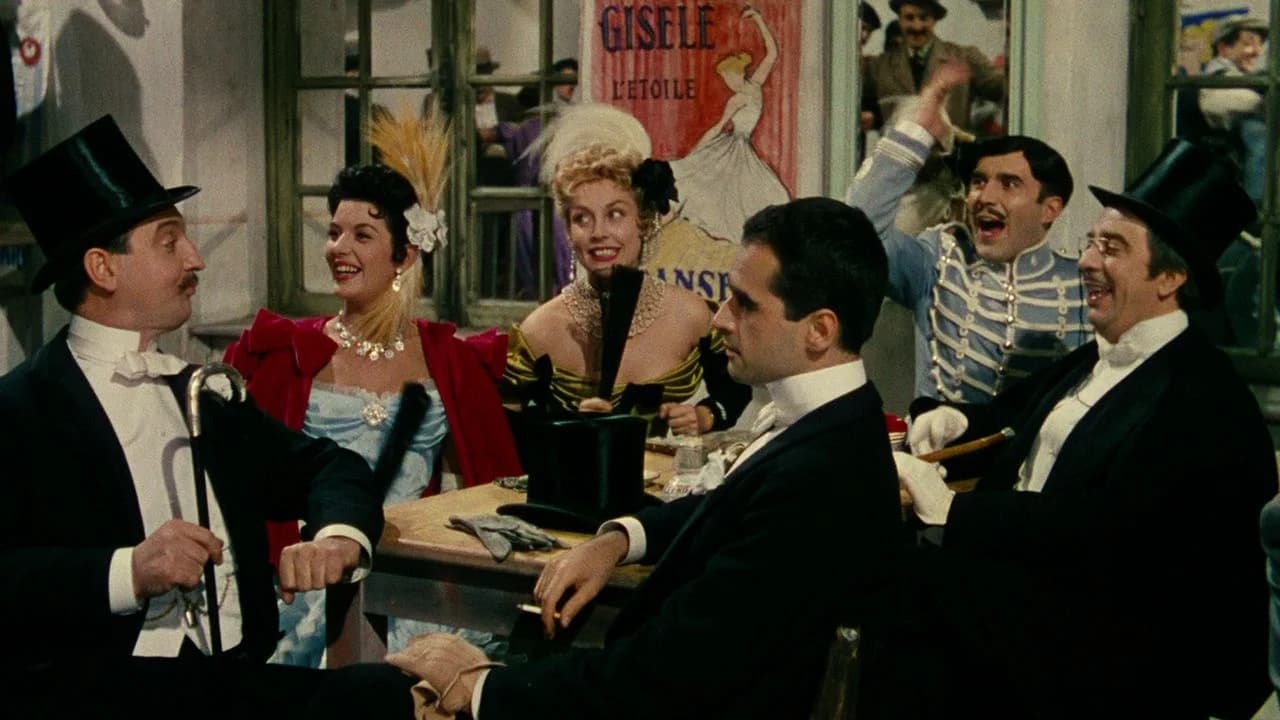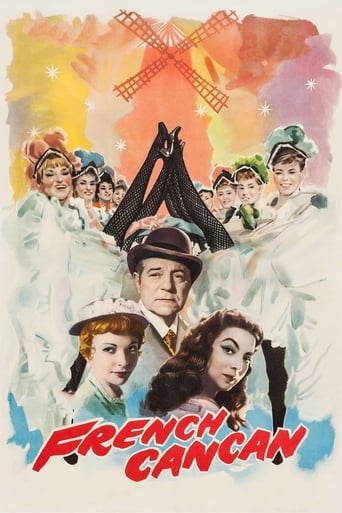

Memorable, crazy movie
... View MoreAt first rather annoying in its heavy emphasis on reenactments, this movie ultimately proves fascinating, simply because the complicated, highly dramatic tale it tells still almost defies belief.
... View MoreEach character in this movie — down to the smallest one — is an individual rather than a type, prone to spontaneous changes of mood and sometimes amusing outbursts of pettiness or ill humor.
... View MoreThere's no way I can possibly love it entirely but I just think its ridiculously bad, but enjoyable at the same time.
... View MoreFrench Cancan is introduced as a "musical comedy" and lives up to the billing in some ways. That is to say that dance gets as much limelight as music, in fact given the final sequence it is dance which would best describe the film. Strange that Renoir wouldn't mark it out as such given his comments about the universality of dance after the production of The River and given the title of the film itself. The depth of field is again appropriated to layer the staging much like in theater. Mobile framing emulates the human spectator to events sooner than constructing space unobtrusively. The pan across the mob fight unravels before the viewer like a comic strip or emaki scroll. There is specular themes like in Golden Coach where Gabin's character asserts "artists are slaves". The film remains lighthearted and humorous and it is no surprise that of his most recent films, Cancan did the best at the box office (Arnoul is delicious in her role). Mise-en-scene is designed with expectations of a painterly aesthetic. A color is lavish to the point of tackiness. Gabin's character later states "we are at the service of the public" and implies that this is all that matters. Sarris comments that Gabin's character as impresario serves as an alter ego for Renoir and reminds us that it would be an "oversimplification to describe him as a humanist." I cannot disagree with Mr. Sarris on those points but as we all know, Renoir's oeuvre plunges even deeper into reflection, representation and meaning.
... View MoreThe story is simple but the execution is marvelous. A Belle Epoque impresario, down on his financial luck, is going to open a new club, the Moulin Rouge, with a new dance, the French cancan. He encounters a working girl and makes her a dancer. She'll become a star. There are several crises to overcome before that happens.The movie is Jean Renoir's tribute to show business, and he puts it on the screen with color, verve, humor, and humanity. There are wonderful performances by all the actors. The leads are Jean Gabin as Henri Danglard, the impresario; Francoise Arnoul as Nini, the girl who'll become a star; and Maria Felix as Lola de Castro, an overwhelmingly tempestuous beauty and Danglard's lover at the start. Gabin exudes confidence, worldly humor and dedication to show business. He even dances a bit. Arnoul is first rate, too. It looks like she was doing her own dances, and as an actress think of a young Leslie Caron with brains and charm.The climax of the movie is the opening of the club, with Felix's star dance, comic songs, a whistler, a Danglar-discovered singer, all moving toward the introduction of the French cancan. The crises happen and are resolved. Then the cancan explodes. Dancing girls come bursting out from the stage, the front of the theater, through posters, down ropes from the balcony. The house swirls with the black tie and tails of the swells and the garish colors of the dancers' gowns. The cancan number lasts probably ten or fifteen minutes or so, all music and gaiety, all high kicks and splits. It's amazing when row after row of the dancers, moving toward the camera through the audience, leap up, legs extended straight forward and backward, backs arched, then land on the dance floor in full splits. I didn't know whether to shout or wince.The last scene of the movie is outside the club, shot from the cobblestone street looking at the entrance. It's a medium shot and from the side street a happy, inebriated fellow in black tie and top hat staggers across, pauses to tip his hat at the camera, then staggers off. A completely charming ending.This really is a marvelous movie.
... View MoreAcknowledgments to Cole Porter from whose lyric CanCan (the title song of his 1953 Broadway show of the same name) I take my one line summary. This is, purely and simply, a Valentine to Paris, the Belle Epoque, the Impressionists, you-name-it. As such it is both stunning and sumptuous.Gabin - who began in the French Music Halls - is superb, but then when isn't he, Arnoul is a revelation. More? Well, the photography is ... the music is ... the ambience is ... aw, what the hell, go see it, do yourself a great big favor. 9/10
... View MoreAlthough it doesn't seem very promising for a long stretch, Renoir's French Cancan ends up being an effortlessly charming film. The story is cliché: a laundry girl, Nini (Françoise Arnoul), is discovered by a night club owner, Danglard (Jean Gabin). Danglard steals her from her baker boyfriend and drops his current girlfriend, both of whom come back for their former lovers. Nini has to choose whether to go back to her humble life with the baker, go on with the show with her employer, oh, or become a princess, as a prince falls in love with her at one point, too. I'm glad the film didn't go for the most obvious choice, as a lesser film certainly would have. The film ends with the opening of Danglard's new night club, the Moulin Rouge, and a couple of gorgeous song and dance numbers. The first of them, "Complainte de la Butte," which also provides the base of most of the film's musical score, is simply one of the most gorgeous songs ever written, and Renoir himself wrote it. If you're a fan of Baz Luhrmann's 2001 film Moulin Rouge!, you'll recognize the tune, as it comes up near the beginning of that film, sung by Rufus Wainwright. Although it isn't very prominent in that film, everyone I know who owns the soundtrack loves it. In addition to having one of the most lovely songs ever written, French Cancan also boasts one of the cutest leading ladies ever to grace the screen. It's hard not to fall head-over-heels in love with that girl. 8/10.
... View More